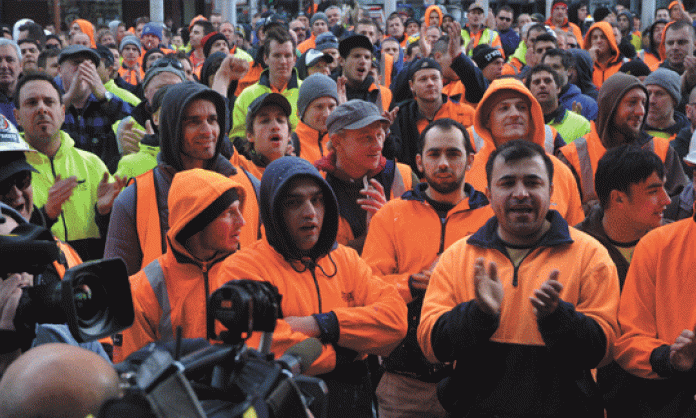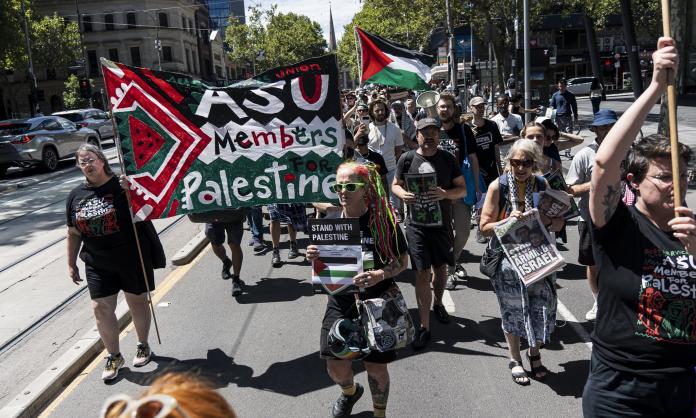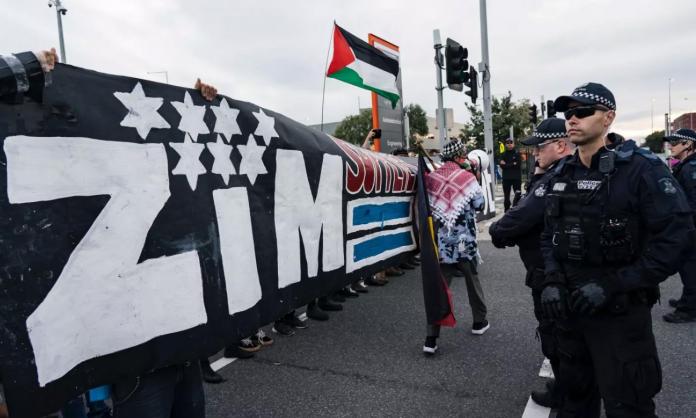It was one of the most powerful union actions this country had seen in years. For two weeks in late August 2012, thousands of construction workers, members of the CFMEU, blockaded the Myer Emporium site in Lonsdale Street, Melbourne.
We were protesting for the right to have union-appointed safety reps and shop stewards on construction sites operated by Grocon – a viciously anti-union property development and construction company.
I described the scene in Socialist Alternative magazine, the forerunner to Red Flag: “As the police numbers swelled, word went out to construction sites all over Melbourne. Soon, every change of the lights brought scores more of the fluoro-jacketed army, determined to keep the picket strong. When the police charged with horses, riot gear, and capsicum spray, hundreds of workers surged back and held them at bay.
“This is our power – the only power that our side has. The power to stop production, and the flow of profits. The power of numbers. The power of our organisation. The power of solidarity.”
One factor in the decline of our unions has been the slowly tightening legal noose, limiting what should be a fundamental right – to stop work and, by picketing, stop our bosses from getting scabs in. The Grocon picket was the sort of public defiance of these restrictions that, if repeated and extended, could lead to a dramatic union revival.
Our ruling class agrees. That is why it is determined to punish the CFMEU.
“Perverse and obstinate resistance to authority”, is how Judge Anthony Cavanough of the Victorian Supreme Court described the union’s crime. Rather than buckle before the numerous injunctions doled out by His Honour on Grocon’s behalf, the CFMEU continued the blockade.
“Contumacious behaviour” is the legal jargon. A crime made worse, in Cavanough’s view, by the fact that the picket was “highly visible and highly memorable”.
“The court must visit the defiance of the CFMEU with a penalty which will not only adequately respond to the scale of the defiance but also act as a general and specific deterrent. No fines of the level previously imposed could do that”, he said.
In March last year, Judge Cavanough put our money where his mouth is, and slapped the union with a $1.25 million fine for “criminal contempt”, a record for an industrial case in an Australian court. The union was also ordered to pay Grocon’s legal costs – an estimated $1 million.
That was just the start.
In late June this year, the CFMEU settled a damages claim by paying $3.55 million to Grocon’s lawyers. In the same week, the union’s Queensland branch was fined $450,000 and threatened with deregistration, for a week-long picket on a Grocon site, a few months before the Emporium blockade.
This one dispute has now cost the union more than $6 million. And there are more cases pending. Fair Work Building and Construction has issued multiple proceedings against the union. High profile anti-union firm Boral is also claiming $20 million in a civil suit.
At these rates, mass murder would be cheaper than running an effective picket. In early 2013, a brick wall collapsed on a Grocon site just a few hundred metres from where the Emporium had been picketed. Three people were crushed to death. Grocon pleaded guilty and was fined $250,000. Grocon could have killed 70 people and still have change left out of what the CFMEU has paid in fines.
Despite its wins in court, Grocon sustained considerable losses in the dispute. At the time of the Lonsdale Street blockade, Grocon was building five of the biggest jobs in Melbourne – the Myer Emporium, the Westpac offices in Collins Street, the Comprehensive Cancer Centre in Parkville, a large office complex at Footscray station and the new Tax Office building in Box Hill. For the first time in generations, five of the biggest commercial construction jobs in Melbourne were being built without any official union presence.
The picture today is quite a contrast. There is an incredible amount of work around the Melbourne CBD, as the speculative bubble in apartment construction approaches its peak. Of the dozens of cranes dotting the skyline, the vast majority fly CFMEU flags.
Grocon is finishing off the Comprehensive Cancer Centre, but the only new project on its Melbourne drawing board is a single apartment tower at 85 Spring Street, currently bogged down with planning issues. The union certainly faces important challenges, including a range of mid-sized builders that have never been seriously tackled by a major industrial campaign. However, none of the major companies have followed Grocon’s example in Melbourne. The CFMEU has paid dearly, but it still has a hold on commercial construction in central Melbourne.
Of course, there’s no future for the union movement in continually paying fines on this scale. History shows that it will take mass defiance to break these shackles. In the 1950s and ’60s, Liberal governments curbed union militancy with an anti-union legal regime known as the penal powers. Introduced under the Chifley Labor Government in the late 1940s, and dramatically extended under Menzies, these laws levied heavy fines on unions that defied the courts.
Famously, in May of 1969, Melbourne Tramways Union leader Clarrie O’Shea refused to hand over the union’s financial records. When he was called before the court, O’Shea told Justice Kerr: “I do not wish to be sworn. I challenge the authority of this court to deal with my case. I am merely defending the funds of my organisation …”
O’Shea’s obstinate refusal led to his jailing for contempt. This sparked a rolling, nationwide general strike, which quickly won his release and made the penal powers a dead letter. The lid was blown off the industrial relations system. A surge in militancy in the years that followed won many of the wages and conditions that Australian workers enjoyed for a generation or more.
The fines levied today dwarf anything imposed under the penal powers. In 2013, socialist historian and union activist Katie Wood wrote: “In the twelve years from 1957 to 1969, the period of the most widespread use of the penal powers, unions were fined, in today’s value, $7.9 million.” Legal costs awarded against the unions were nearly as much again – but this was in relation to nearly 800 different fines over more than a decade.
With fines, costs and legal settlements in the Grocon cases alone passing $6 million, it’s clear that the ruling class has overcome any fear it once had about imposing colossal fines on our unions.
It’s not going to be easy to repeat the O’Shea strike today. The bosses have learned some lessons. They are very reluctant to make a martyr out of any individual unionist. When the construction unions have campaigned to defend individual unionists such as Ark Tribe, Noel Washington and Bob Carnegie, the courts found a technicality that allowed the charges to be dropped.
Refusing to pay fines is more difficult. But such a strategy of defiance is what we need if we are to break the manacles applied to our most important democratic right – the right to strike.











